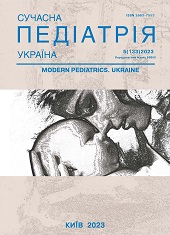Possibilities of verification of community-acquired pneumonia in children by changes in multiparametric polarization-phase microscopy of polycrystalline membranes of pulmonary expiratory condensate
DOI:
https://doi.org/10.15574/SP.2023.133.24Keywords:
children, pneumonia, COVID-19, diagnosis, laser polarimetry, pulmonary expiratory condensateAbstract
The problem of early diagnosis and selection of target treatment of pneumonia in children during the years of the COVID-19 pandemic became acute, in particular, with regard to predicting the risk of severe disease, which prompted the search for new non-invasive diagnostic methods for verifying inflammation of the lung parenchyma.
Purpose - to increase the effectiveness of the diagnosis of community-acquired pneumonia in children based on the analysis of the diagnostic value of the method of multiparameter polarization-phase microscopy of polycrystalline membranes of pulmonary expiratory condensate in the aspect of differential diagnosis in relation to patients with infectious inflammatory diseases of the upper respiratory tract.
Materials and methods. In the Chernivtsi Regional Pediatric Hospital, 98 children with infectious inflammatory respiratory diseases were examined, in particular, 64 patients with pneumonia and 34 children suffering from infectious and inflammatory diseases of the upper respiratory tract. Biological material was collected from patients on the first day of hospitalization. The investigation of the laser-polarimetric images structure of pulmonary expiratory condensate was carried out in the traditional arrangement of the Stokes polarimeter. A universal analytical statistical approach was used for each two-dimensional distribution of the polarization azimuth values of the polycrystalline membranes of pulmonary expiratory condensate, namely, the determination of a set of statistical moments of the 1st to 4th orders (mean, variance, skewness and kurtosis). The obtained results were analyzed using methods of clinical epidemiology.
Results. Polarization azimuth indexes and histograms of their values were determined for images of pulmonary expiratory samples of both groups of children. The comparative analysis of the obtained data confirmed that both samples are characterized by optical heterogeneity as an increase in the sensitivity of polarization mapping of lung expiratory samples. An increase in the optical anisotropy of polycrystalline membranes of lung expiratory condensate from patients with pneumonia was also revealed. The obtained indexes of all statistical moments for the purpose of pneumonia verifying had high sensitivity exceeding 98% and sufficient specificity.
Conclusions. Sufficient diagnostic value of the method of multi-parameter polarization-phase microscopy of pulmonary expiratory air, which can be used in the verification of inflammation of the pulmonary parenchyma in children relative to patients with infectious inflammatory diseases of the upper respiratory tract, has been established.
The research was carried out in accordance with the principles of the Helsinki Declaration. The study protocol was approved by the Local Ethics Committee of participating institution. The informed consent of the patient was obtained for conducting the studies.
No conflict of interests was declared by the authors.
References
Bachynskyi VT, Vanchulyak OYa, Syvokorovska A-VS, Garazdyuk MS, Palivoda OG. (2015). Prospects for the use of laser polarimetric methods for the study of biotissues and environments of the human body. Experimental medicine and morphology. Actual problems of modern medicineю 15; 3 (51); Part 2: 193-198. URL: file:///Users/romantkachuk/Downloads/apsm_2015_15_3(2)__45.pdf.
Bhuiyan MU, Blyth CC, West R et al. (2019). Combination of clinical symptoms and blood biomarkers can improve discrimination between bacterial or viral community-acquired pneumonia in children. BMC Pulmonary Medicine. 19: 71. https://doi.org/10.1186/s12890-019-0835-5; PMid:30940126 PMCid:PMC6444754
Borovkova M, Peyvasteh M, Dubolazov O, Ushenko Y, Ushenko V, Bykov A et al. (2018). Complementary analysis of Mueller-matrix images of optically anisotropic highly scattering biological tissues. Journal of the European Optical Society. 14 (1): 20: 1-8. URL: https://jeos.springeropen.com/articles/10.1186/s41476-018-0085-9. https://doi.org/10.1186/s41476-018-0085-9
Götzinger F, Santiago-García B, Noguera-Julián A et al. (2020, Jun 25). COVID-19 in children and adolescents in Europe: a multinational, multicentre cohort study. Lancet Child Adolesc Health. 4: 53-61. https://doi.org/10.1016/S2352-4642(20)30177-2; PMid:32593339
Ministerstvo rozvytku ekonomiky, torhivli ta silskoho hospodarstva Ukrainy. (2020). Opys do patentu na korysnu model. URL: https://iprop-ua.com/inv/pdf/jdgkkked-pub-description.pdf.
Ministry of Health of Ukraine. (2020). Providing medical assistance for the treatment of coronavirus disease (COVID-19). Order of the Ministry of Health of Ukraine No. 762 dated 02.02.2020 on the approval of the protocol with changes and additions.
Nesterovska O. (2021). Recommendations for diagnosis and treatment of pneumonia in children. LLC «Publishing house «Health of Ukraine. Medical publications». Pediatrics. 1 (57): 23. URL: https://health-ua.com/article/64329-rekomendatc-shodo-dagnostiki-talkuvannya-pnevmon-udtej.
Sinyachenko OV, Yermolaeva MV, Aliyeva TYu et al. (2021). Clinical-pathogenetic significance of molecules of average mass of different fractions in pulmonary expiratory air of patients with rheumatoid arthritis. Tuberculosis, lung diseases, HIV-infection. 1 (44): 60-66. ISSN 2220-5071 (Print), ISSN 2522-1094 (Online). https://doi.org/10.30978/TB2021-1-60
Volosovets OP, Bolbot YuK, Abaturov OE et al. (2020). The dynamics of changes in the incidence rate of pneumonia in children of Ukraine over the past 20 years. Medical perspectives. 25; 4: 174-181. https://doi.org/10.26641/2307-0404.2020.4.221680
Downloads
Published
Issue
Section
License
Copyright (c) 2023 Modern pediatrics. Ukraine

This work is licensed under a Creative Commons Attribution-NonCommercial 4.0 International License.
The policy of the Journal “MODERN PEDIATRICS. UKRAINE” is compatible with the vast majority of funders' of open access and self-archiving policies. The journal provides immediate open access route being convinced that everyone – not only scientists - can benefit from research results, and publishes articles exclusively under open access distribution, with a Creative Commons Attribution-Noncommercial 4.0 international license (СС BY-NC).
Authors transfer the copyright to the Journal “MODERN PEDIATRICS. UKRAINE” when the manuscript is accepted for publication. Authors declare that this manuscript has not been published nor is under simultaneous consideration for publication elsewhere. After publication, the articles become freely available on-line to the public.
Readers have the right to use, distribute, and reproduce articles in any medium, provided the articles and the journal are properly cited.
The use of published materials for commercial purposes is strongly prohibited.

